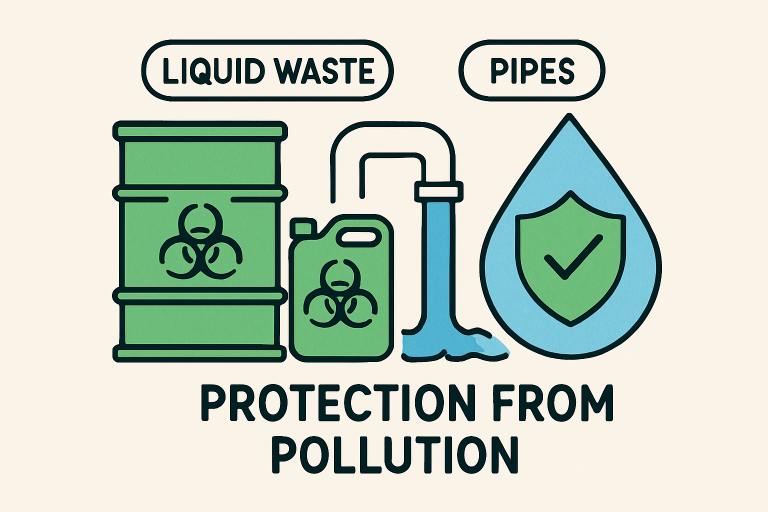Table of Contents
- 1 What Is Liquid Waste?
- 2 Common Sources and Types of Liquid Waste
- 3 Environmental and Health Impacts of Improper Disposal
- 4 Regulations and Guidelines for Disposal
- 5 Reliable Methods of Liquid Waste Disposal
- 6 Emerging Technologies in Liquid Waste Management
- 7 Best Practices for Businesses and Individuals
- 8 Future Trends and Challenges
- 9 Conclusion
What Is Liquid Waste?
Liquid waste encompasses any form of waste that exists primarily in a fluid state. This category is broad—it includes household greywater, industrial oils and solvents, hazardous chemicals, and even agricultural runoff. As cities and businesses strive to become more sustainable, handling these wastes responsibly becomes a vital public and environmental service. For instance, professional liquid water disposal Detroit providers play a crucial role in mitigating risks and ensuring proper disposal practices throughout urban and industrial landscapes.
Understanding liquid waste involves recognizing its various physical and chemical characteristics. This helps determine the appropriate disposal or treatment method while adhering to environmental and health standards. Often, the safe management of liquids hinges on proper identification from the source to the point of disposal, which is why engaging experienced liquid waste disposal services is increasingly seen as industry best practice for both businesses and municipalities.
Common Sources and Types of Liquid Waste
The sources of liquid waste are as diverse as the societies that produce them. Residential households generate wastewater through daily activities such as bathing, cleaning, and laundry. On the other hand, commercial and industrial sectors release oils, coolants, chemical rinse waters, and manufacturing byproducts. Even the healthcare sector generates unique bio-liquids, including laboratory wastes and medical cleaning fluids. The agricultural industry adds another layer, with fertilizers, pesticides, and animal effluents all requiring careful management to prevent pollution.
Each waste stream presents specific management challenges that demand tailored solutions, especially in metropolitan regions where volumes and complexity are high. Categorizing waste by origin and risk profile is foundational to controlling environmental impact.
Environmental and Health Impacts of Improper Disposal
The mishandling of liquid waste can have catastrophic results for both public health and the environment. When industrial chemicals, untreated sewage, or hazardous liquids are released into waterways or soil, they can contaminate drinking water sources, disrupt aquatic ecosystems, and linger in the environment for decades. This not only endangers aquatic species but also exposes humans to long-term health risks such as cancer, neurological disorders, and waterborne diseases. According to research published by the EPA on cyanotoxins and drinking water, even small-scale spills or leaks can cause persistent contamination events in local communities.

Regulations and Guidelines for Disposal
To mitigate these risks, governments and environmental agencies worldwide have implemented stringent regulations governing the handling, transportation, and disposal of liquid waste. In the United States, the Resource Conservation and Recovery Act (RCRA) and supplementary state and municipal codes form the backbone of these efforts. Compliance with such regulatory frameworks ensures both workplace safety and environmental protection; non-compliance often results in substantial financial penalties and reputational harm.
Staying abreast of changing guidelines requires not only regulatory monitoring but also partnership with certified waste handlers and ongoing staff training. This approach ensures that new substances or waste streams do not introduce compliance gaps, which could lead to accidental pollution.
Reliable Methods of Liquid Waste Disposal
- Neutralization: Chemically adjusting acidic or basic liquids balances their pH, rendering them safe for further treatment or disposal.
- Filtration and Sedimentation: Mechanical separation removes solids and particulates from wastewater before it enters treatment plants or natural waterways.
- Biological Treatment: Facilities use microorganisms to break down organic contaminants—a cornerstone technique in municipal sewage management.
- Incineration: Highly hazardous or non-recyclable liquids are incinerated, destroying dangerous compounds and reducing their environmental persistence.
Each disposal or treatment method is chosen based on the specific physical and chemical profile of the liquid waste, aligning with both regulatory and sustainability objectives.
Emerging Technologies in Liquid Waste Management
Innovation is transforming the future of liquid waste disposal. Advanced membrane filtration systems, for example, are capable of removing microscopic contaminants more efficiently than traditional filters. Meanwhile, hybrid chemical-physical processes are optimizing the decomposition and separation of hazardous waste. Automation, enabled by sensor-based monitoring and AI-driven controls, is improving safety, efficiency, and transparency at every stage of the liquid waste lifecycle. Breakthroughs summarized in the Wastewater Digest: Emerging Technologies in the Wastewater Sector suggest that scalable, sustainable solutions are closer than ever to mainstream adoption.
Best Practices for Businesses and Individuals
- Keep detailed records and inventories of all liquid waste produced.
- Segregate hazardous and non-hazardous wastes using properly labeled, leak-proof containers.
- Train employees or household members about safe handling, spill response, and first-aid.
- Engage only certified providers for disposal and regularly audit disposal partners.
- Monitor and update procedures as regulations evolve and new risks emerge.
- Adopt environmentally friendly chemicals where possible, and repair leaks or spills immediately.
By fostering a culture of safety, responsibility, and education, communities and companies can significantly reduce their environmental footprint and regulatory liability.
Future Trends and Challenges
As global eco-consciousness grows, the liquid waste management sector is evolving rapidly. Closed-loop recycling systems, biodegradable chemicals, and digital tracking are redefining best practices. Despite these advancements, practical challenges remain—particularly for older infrastructures and underfunded municipalities, which may struggle to finance upgrades or retrain personnel. Future success will depend on coordinated action between regulators, industry leaders, and technology providers to bridge these gaps and keep pace with regulatory and societal expectations.
Conclusion
Responsible liquid waste disposal is a collaborative and evolving process that is fundamental to safeguarding public health and the environment. From understanding sources to adopting best practices and benefitting from technological advances, everyone—businesses, municipalities, and individuals—plays a part in reducing risks and ensuring clean water for the future. By embracing stricter regulations, technological innovation, and proactive education, society can turn the tide on liquid waste’s impact, setting the foundation for a cleaner, safer world.
